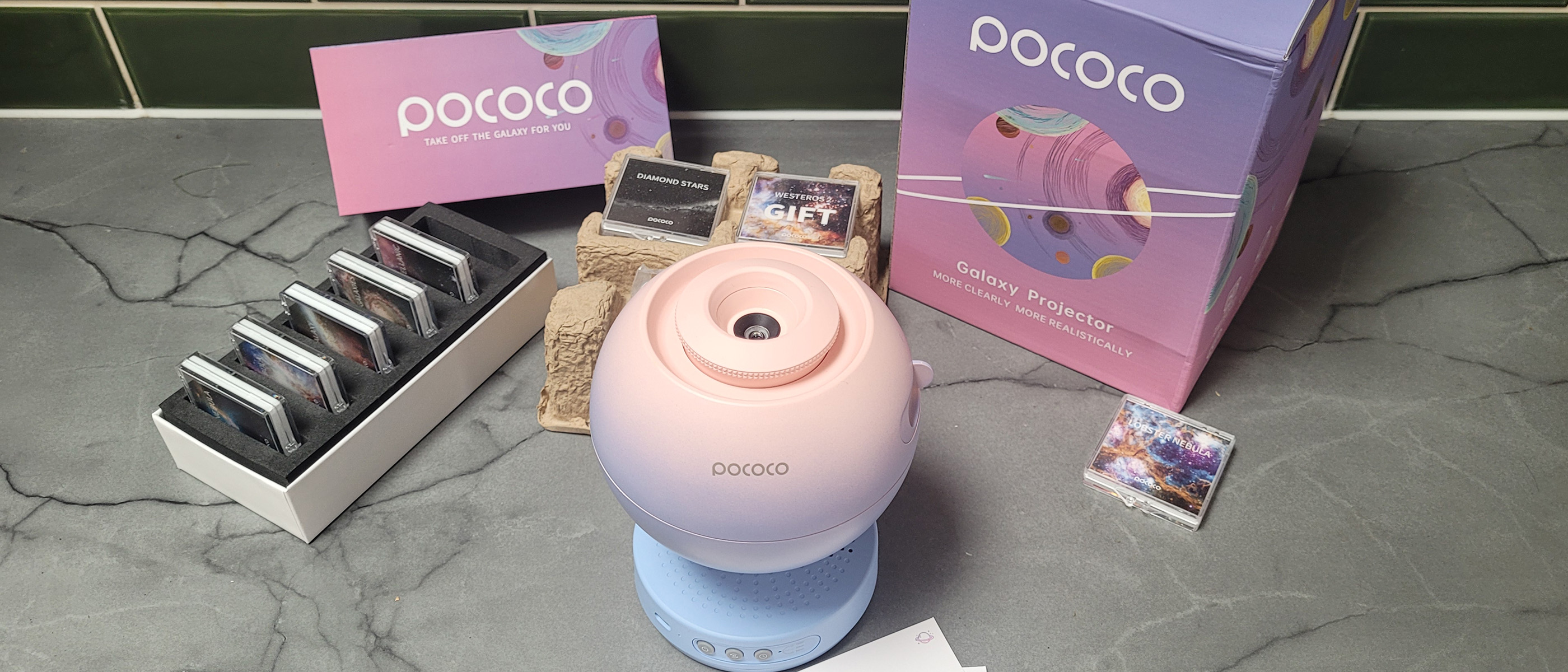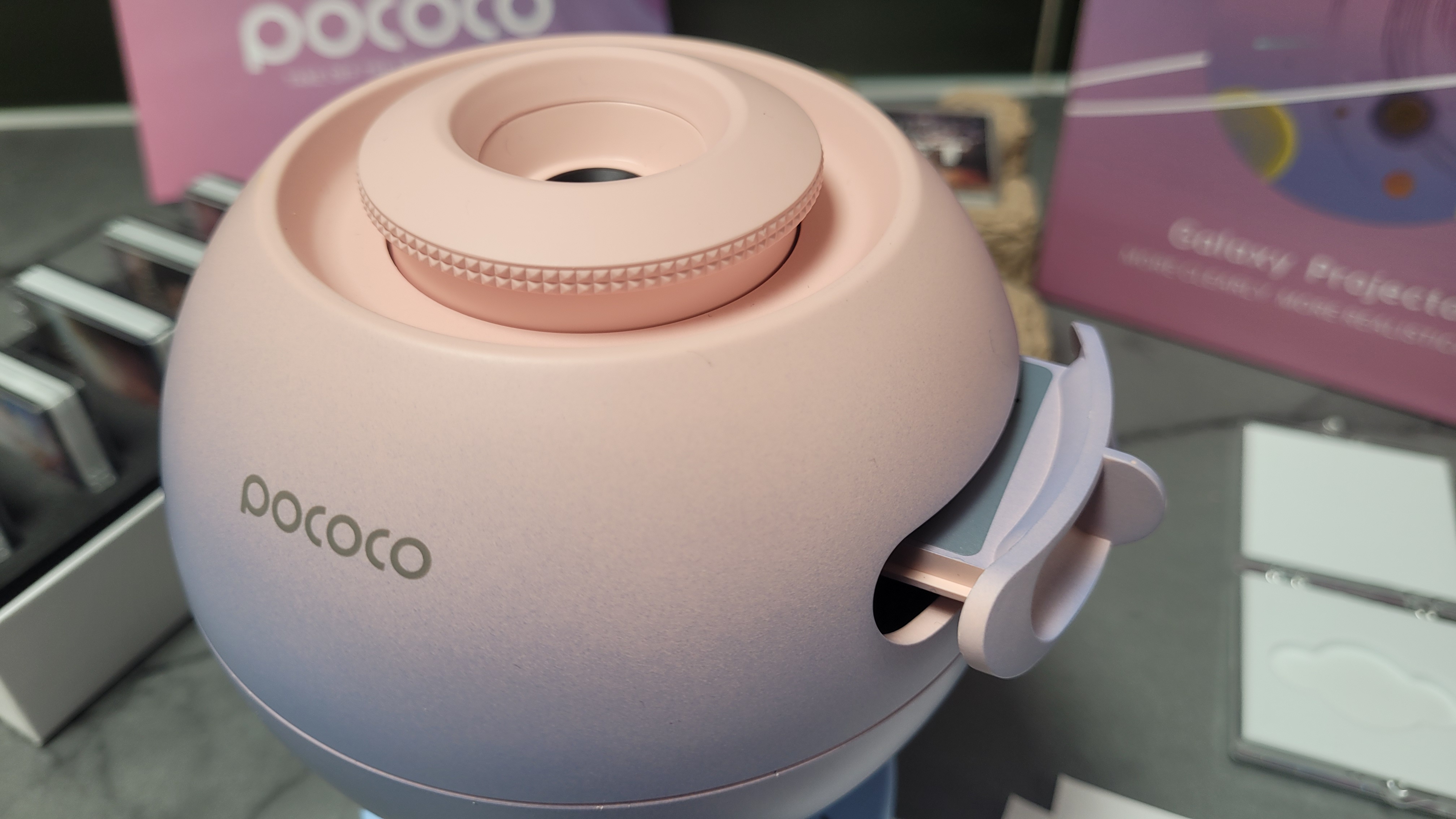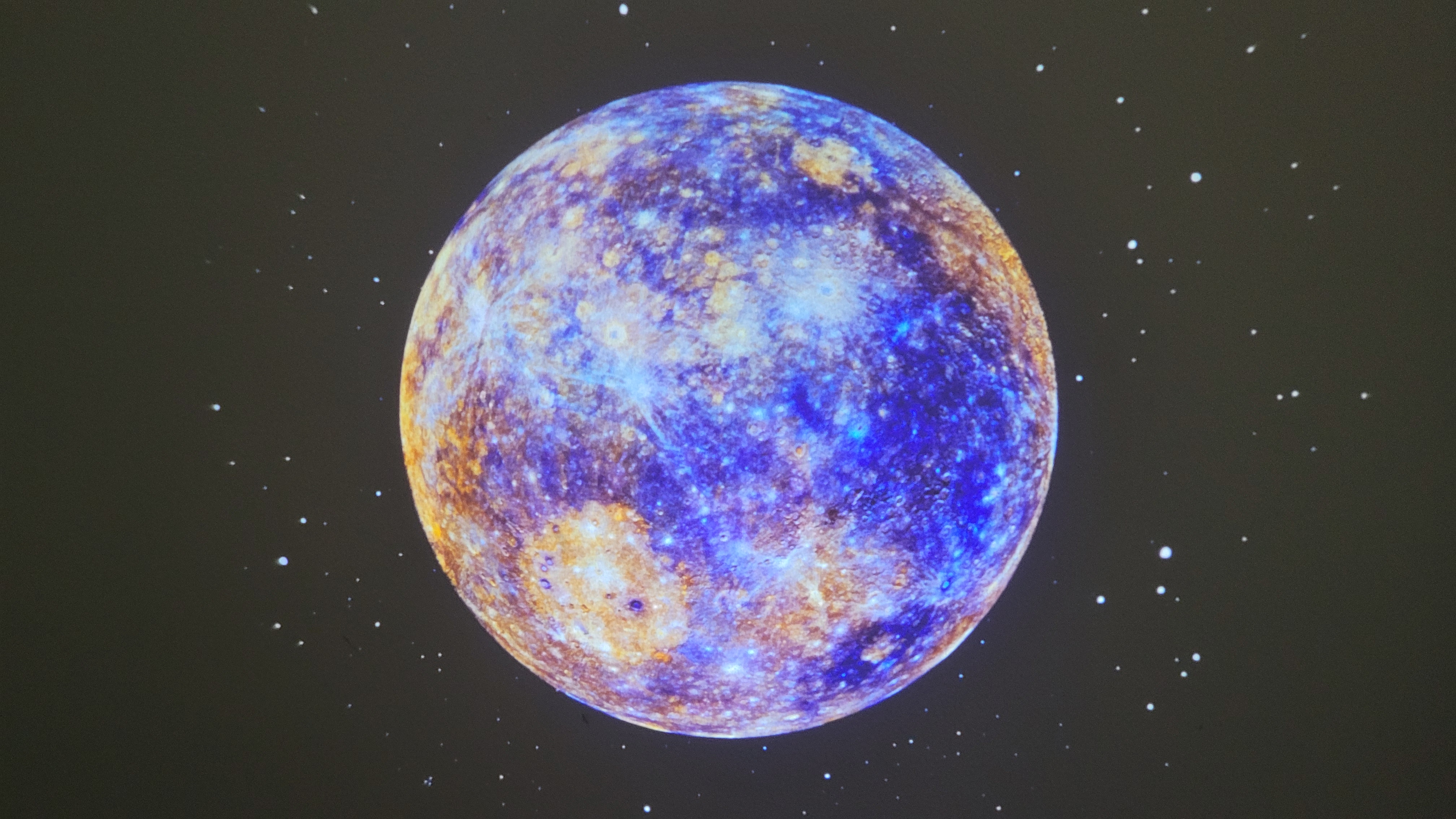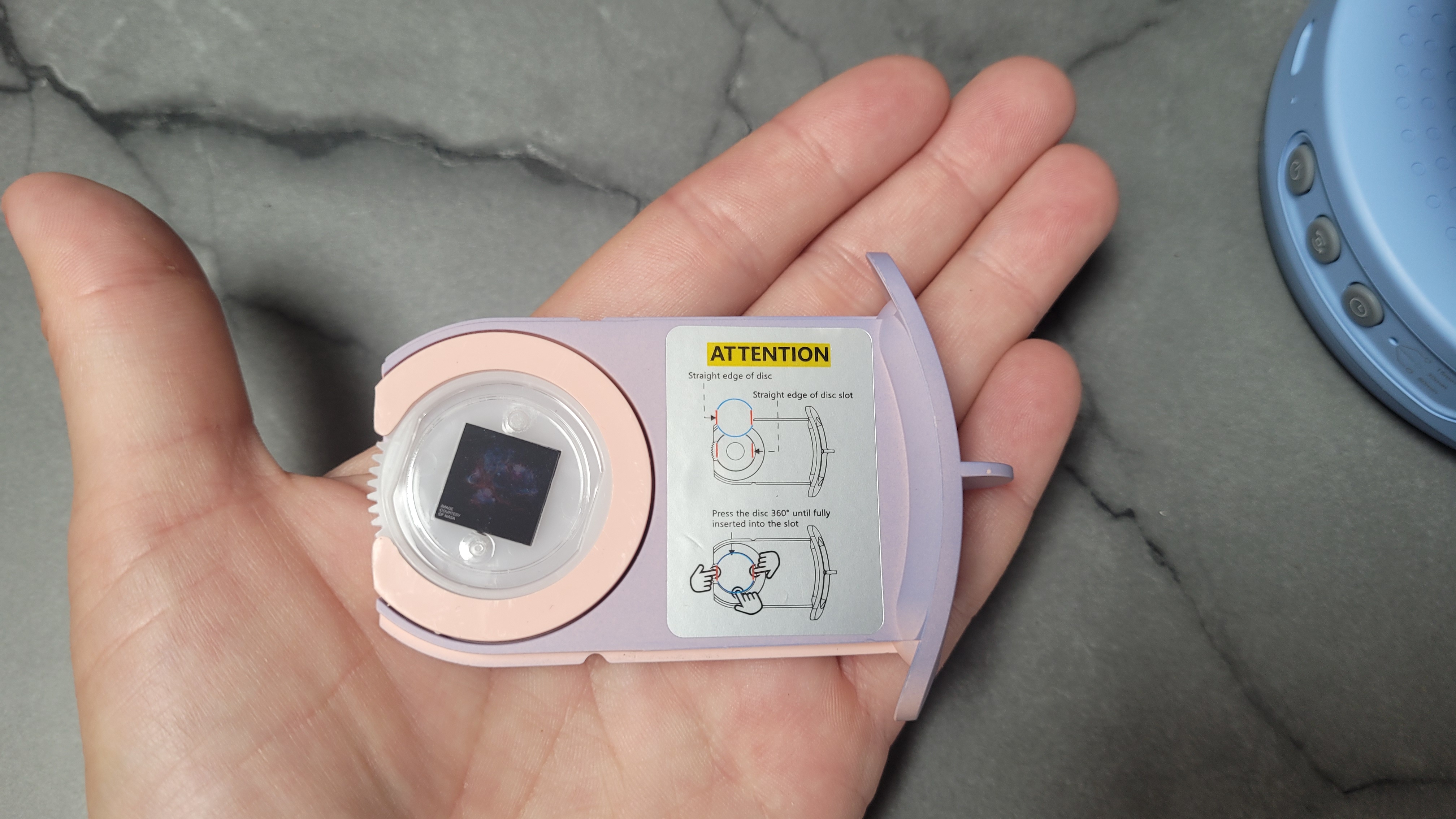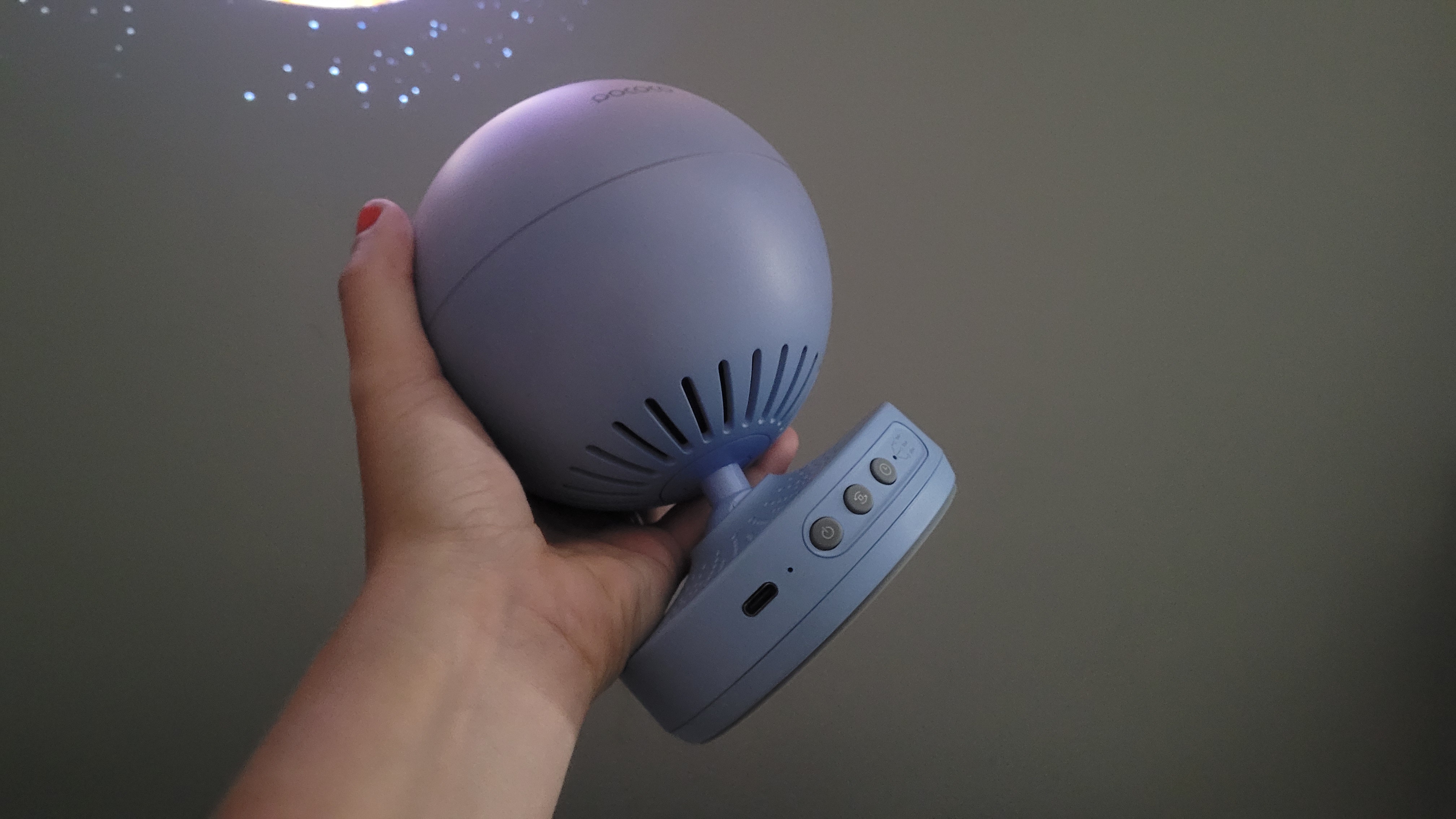Live Science Verdict
The Pococo Galaxy Star projector is an affordable alternative to the more expensive star projectors like the Sega Toys Homestar Flux. It offers the same functionality and image quality (if not better), and it is also rechargeable, which gives you more flexibility in terms of where you can point the projections.
Pros
- +
Rechargeable
- +
Small
- +
Affordable
Cons
- -
Only load one disk at a time
- -
Unusual marketing
- -
The white version is more expensive
Why you can trust Live Science
When filtering through the vast market of star projectors, we saw the Pococo Galaxy home planetarium had an extensive collection of expandable image disks, LED projections and a focus ring.
it doesn't have the dreaded tacky laser stars, it had a small spherical shape, and the image quality was sharp and vibrant (in pictures available online).
Size: 157x 120x 120 mm
Bulb Type: LED
Laser: None
Control: On-body
Rotation: Yes
Sleep timer: Yes
Speaker: No
Projection Surface: 12 sq m
This all seemed to sound very familiar — featuring the functionality of the Sega Toys Homestar Flux and the Orzors Galaxy Lite we have reviewed recently, that both score very highly as some of the best star projectors on the market. It doesn't have many ratings on Amazon, but it does score over four stars out of five, with comparisons to the more expensive models within the customer feedback. We figured for the reasonable price, less than $100, we'd give it a go.
We've had the projector for a couple of weeks now, and have used it in various rooms throughout the house to make the most of the wireless operation (once charged). Read on for our thoughts.
Pococo Galaxy star projector: Design
- Two colors available
- Simplistic, discrete design
- Odd marketing direction
The Pococo Galaxy Star Projector is a small device, small enough to fit on a shelf without leaving too much of a footprint. Although the model we tested is the blue and pink version, the colors are fairly muted, so it doesn't look garish. It will blend nicely with most decors, although a white version is available for a slightly higher price.
The spherical projector pivots on a small stand, leaning forwards and backward 60 degrees. Though this doesn't sound like much, you can also physically turn the whole device around 360 degrees, especially when it's running off the rechargeable battery, as there are no wires to get in the way. We found the projection area adequate; the only thing you can't do easily is make the projection low on the wall or floor, which most people wouldn't have a reason to do.
The Pococo packaging is eye-catching, and the marketing is clearly geared toward purchasing this as a gift for a female. We don't necessarily agree with some strange wording on the Pococo website and within the Amazon description. Still, we're giving Pococo the benefit of the doubt and assuming that perhaps accidental body shaming (we know, bizarre to be talking about this in a star projector review) has come about by being lost in translation.
Get the world’s most fascinating discoveries delivered straight to your inbox.
If you're an eco-conscious shopper looking for an environmentally friendly star projector, don't let the token bit of green-washing fool you. Pococo has claimed the device has a low-Carbon design and that the packaging is 100% recyclable. We're dubious about this due to the amount of plastic you receive with the packaging, including the individual plastic cases for the disks. Of course, this isn't a reason not to buy the Pococo projector; we just don't want people to purchase the product under false pretenses.
The projector's operation is simply three buttons, and there is a USB-C port for charging. This keeps the device neat and clutter-free.
Pococo Galaxy star projector: Performance
- Excellent quality projections
- Bright, even in the daytime
- Vivid imagery
As a projector, this Pococo model serves its purpose exceptionally well. The images projected are crystal clear — once you've focused them — bright and vivid. If you're projecting onto a close proximity surface, the projection will appear in quite a prominent circle. The further away you move the projector, the less harsh the circular edge will appear, resulting in a far more immersive experience.
The focus wheel allows you to quickly focus the image from a range of distances; it's a large wheel so it could be easily operated by children or by individuals with little mobility in their hands. It's even easy to focus while wearing gloves should you happen to keep them on indoors.
The provided disks, which are pretty tiny, also fit the Orzorz Galaxy Lite Home Planetarium and vice versa. We've established these are both pretty much the same projector but in different bodies. The projections and image quality are just as impressive in both models. In an ideal world, we'd like the option to load two or three disks at once in a tray that rotates to your desired image to make switching between images quicker. That said, it really takes no time at all to remove the disk and pop another one in.
There is one rotation speed, which is fairly slow and calming. There is no option to alter the speed of the rotation of the projections — this didn't bother us, and we think that speed settings are generally best reserved for more non-scientific models like the BlissLights Sky Lite Evolve where the primary purpose is to create an ambiance dependent on the mood of the room.
Because there is only one slow speed setting, any noise coming from the projector is negligible; you can't hear anything unless you physically press your ear onto the device. Perfect for drifting off to sleep with or accompanying a film without a noisy distraction.
Pococo Galaxy star projector: Functionality
- Rechargeable
- Simple operation
- No remote
Functionality-wise, this projector couldn't be simpler. There's no speaker, lasers, integrated radio or sound effects like on other models, it's simply a good-quality projector.
It has a very simple three-button operation. One button turns it on, one starts or stops the rotation, and one activates the sleep timer. That's all there is to it, there's no need for a remote, fancy apps or Bluetooth connectivity — less to go wrong!
The fact you can charge the projector up is a big plus over some models (including the Homestar Flux). You aren't restricted to placing your projector next to a power socket, you can even take it out and about in a motorhome or campervan.
If you don't set a sleep timer, it will automatically power off after two hours to preserve the battery.
Should I buy the Pococo Galaxy Star Projector?
If you're looking for a good quality but simple star projector, to project real-looking imagery into your space at home, we can't really think of a reason to choose a more expensive model over this one.
The disk expansion packs are much cheaper than competitors — four different expansion packs are available for $50 per box, versus the Homestar Flux's $20 per disk price tag. If you are purchasing the projector for a friend or relative, they may be thankful that you picked the model that has more affordable disks when they come to expand their collection in the future.
If the Pococo Galaxy Star Projector isn’t for you
There are now multiple-star projectors on the market, so many that you might be tempted to go for the cheapest as surely they all must do the same thing?
We've tried and tested numerous models and have described who would be the best recipients of them in our best star projectors guide.
The most similar model to the Pococo is the Orzors Galaxy Lite Home Planetarium Star Projector. As mentioned earlier, it is effectively the same tech in a different body, so we'd recommend choosing whichever is cheaper.
For a non-scientific projector, consider the BlissLights Sky Lite Evolve. This projector's primary purpose is to create an exciting, colorful atmosphere for parties, bedrooms, gaming rooms and beyond. Like the Pococo, it has a small, discreet, spherical design, and you can control the lights and lasers using a Smartphone app.
A young child might prefer the Dinosaur Egg Galaxy Star Projector that we reviewed recently. Like the aforementioned SkyLite Evolve, it isn't scientific or educational, but it's a novelty item to add ambiance to a room or to use as a sleep aid. The hatching dinosaur egg design will appeal to any young space or dinosaur fan, as will the novelty astronaut design of the Astronaut Starry Sky Projector.
Finally, we've mentioned it a few times throughout this review — the Sega Toys Homestar Flux is still a favorite amongst those who want to bring the cosmos indoors by projecting realistic imagery, and who don't mind paying a considerable amount more money for the Sega Toys brand name.

Tantse Walter is a writer, photographer, and travel enthusiast who has spent over a decade facilitating global adventurous expeditions. She loves getting into the nitty-gritty of sourcing and planning itineraries, getting out and about in nature, and admiring the night sky. She is currently a contributing writer to both Space.com and LiveScience.com.
